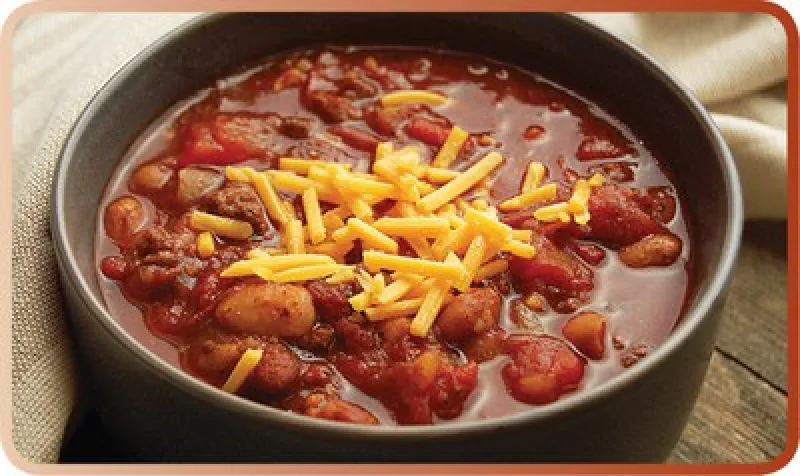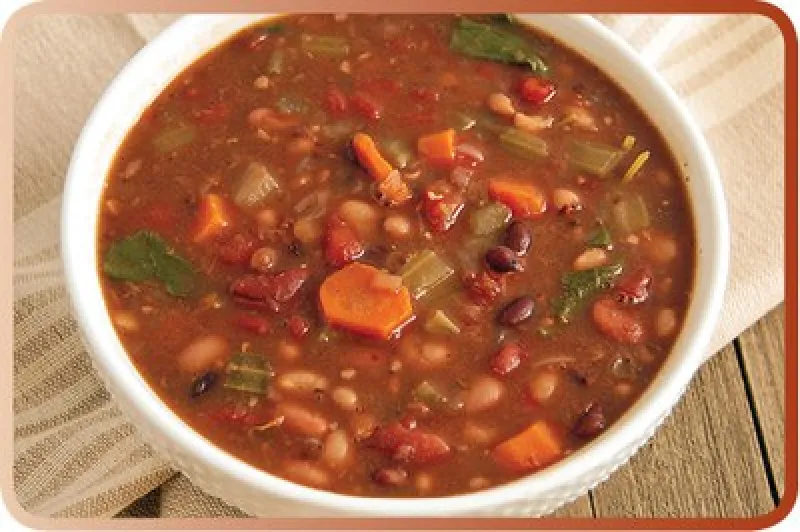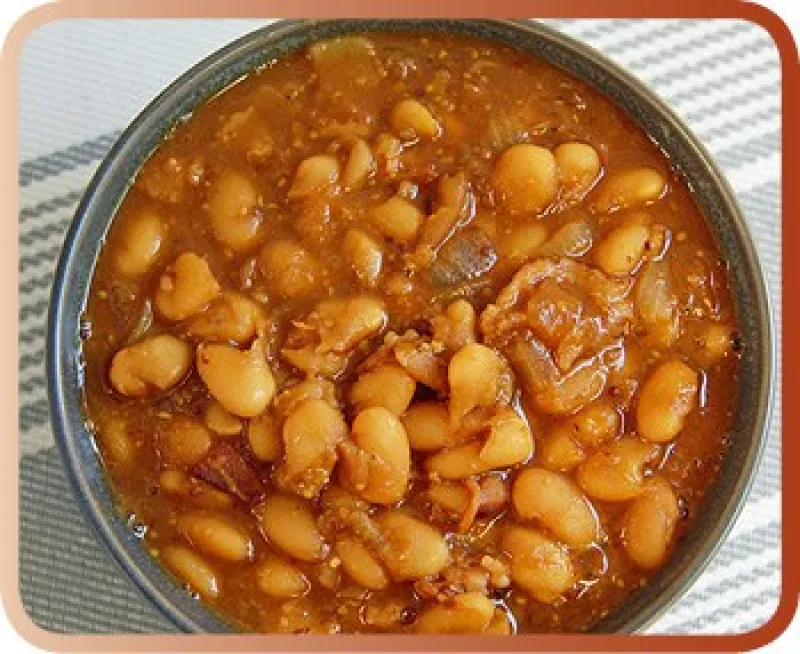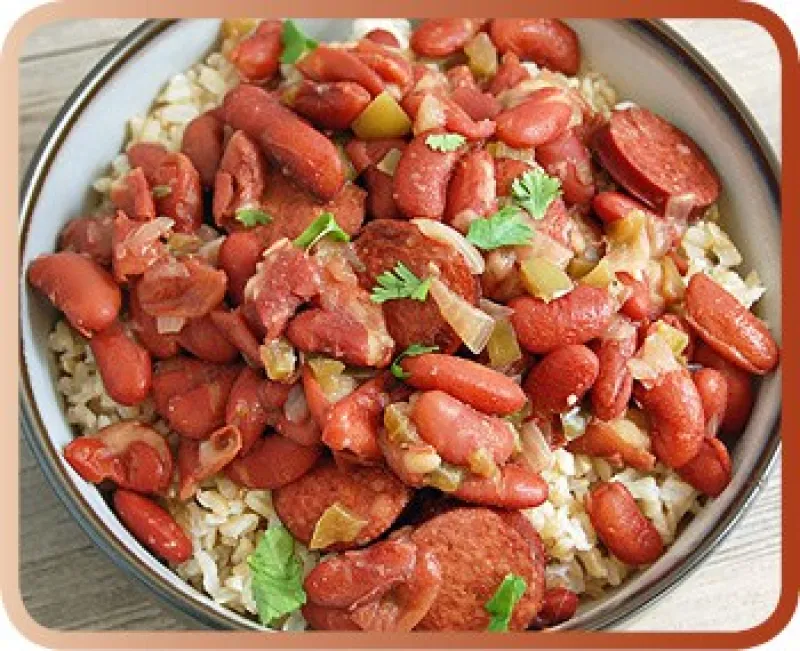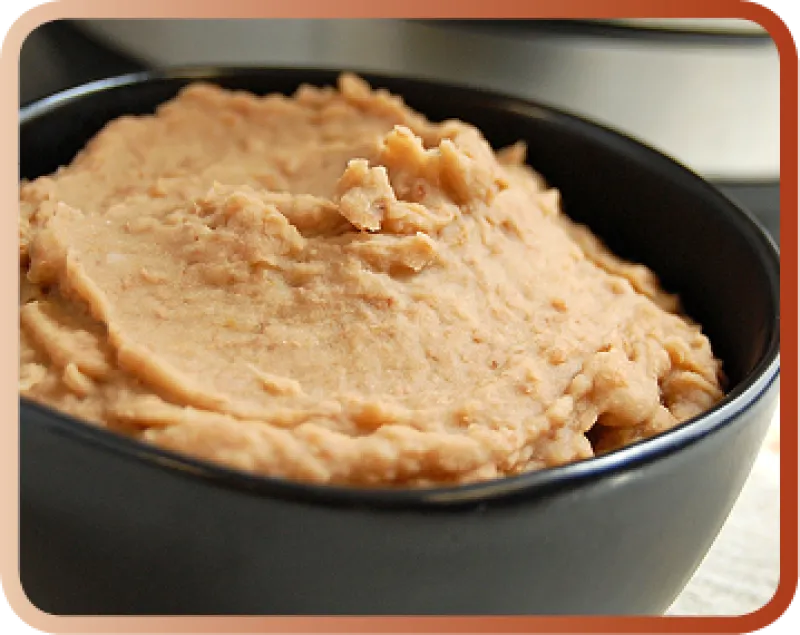Key to abbreviations
qt. = quart
oz. = ounce
g = gram
lb. = pound
Tbsp. = tablespoon
mg = milligram
c. = cup
tsp. = teaspoon
These recipes were tested using electric multicookers.
Classic Chili
1 c. pinto beans, dry
½ c. kidney beans, dry
4 qt. water plus 3 Tbsp. salt (for soaking beans)
2 Tbsp. olive oil
1 lb. ground beef, lean
2 c. fresh onion, chopped
1 red bell pepper, chopped
2 tsp. garlic, minced
2 Tbsp. chili powder
1 Tbsp. oregano, dry, crushed
1 Tbsp. cumin
½ tsp. salt or to taste
½ tsp. black pepper
⅛ tsp. cayenne pepper
4 c. beef broth, reduced-sodium
1 can (14-oz.) diced fire roasted tomatoes
1 can (6-oz.) tomato paste
Optional toppings: sour cream, shredded cheddar cheese, chopped red onions, corn, diced avocado or tortilla chips
Two hours prior to cooking, place beans in 4 quarts of water with 3 tablespoons of salt and allow the beans to soak for at least two hours. After two hours, drain and rinse beans. On the sauté setting, heat oil in the bottom of the pot; brown ground beef. Rinse then prepare vegetables as shown. Stir in onion, bell pepper and garlic; sauté until onion is soft, about two minutes. Add chili powder, oregano, cumin, salt, black pepper and cayenne pepper, and stir until fragrant, about one minute. Stir in broth, diced tomatoes, tomato paste and beans. Pressure cook for about 20 minutes and then allow a natural pressure release for 20 minutes. Release any remaining pressure and remove lid. Cook chili on sauté setting until it thickens, stirring frequently, about five minutes. Serve with your choice of toppings.
Makes 12 (1-cup) servings. Each serving has 200 calories, 5 g fat, 24 g carbohydrate, 7 g fiber and 420 milligrams sodium.
7-Bean Vegetarian Soup
½ c. navy beans, dry
½ c. black beans, dry
¼ c. pinto beans, dry
¼ c. kidney beans, dry
¼ c. black-eyed peas, dry
¼ c. red lentils, dry
¼ c. green lentils, dry
1 Tbsp. olive oil
4 carrots, chopped
4 celery stalks, chopped
1 large onion, chopped (about 1½ c., chopped)
1 Tbsp. garlic, minced
8 c. low-sodium vegetable broth
1 tsp. salt
½ tsp. black pepper
½ Tbsp. thyme, dry
½ tsp. sage, dry
1 (14-oz.) can diced tomatoes
2 bay leaves
1 c. kale, chopped
Turn the pressure cooker to sauté function. Add oil and heat until the oil shimmers. Rinse then prepare vegetables as directed. Sauté carrots, celery, onion and garlic until softened and translucent. Add remaining ingredients except kale and cover with the lid seal to lock. Press the manual pressure cook button and set the timer to 20 minutes. Let the pressure release naturally for 10 to 15 minutes. Release any remaining pressure and remove cover. Add kale and cook for five more minutes. Then remove the bay leaves and serve.
Makes 11 (1-cup) servings. Each serving has 170 calories, 2 g fat, 9 g protein, 30 g carbohydrate, 7 g fiber and 360 mg sodium.
Boston Baked Beans
1 lb. Great Northern beans, dry
8 c. water
⅓c. molasses
⅓c. brown sugar
3 Tbsp. Dijon mustard
8 oz. bacon, cut into half-inch pieces
1 medium onion, diced
Combine the beans and water in an electric pressure cooker. Secure the lid and set on manual; cook for 20 minutes. Allow a natural pressure release, about 15 minutes, then release any remaining pressure. Beans should be mostly cooked through but still firm. Save 1½ cups of liquid and set it aside. Lift the hot inner pot out of the pressure cooker and drain the beans into a colander in the sink carefully to avoid burning yourself. Wash the pot and return it to the pressure cooker. In a small bowl, whisk together the molasses, sugar, mustard and reserved bean cooking liquid. Set aside. Turn the pressure cooker to sauté and add the bacon. Sauté until some fat is in the bottom of the pot, about five minutes. Then add onion and sauté until it is translucent, about five more minutes. Stir the beans and the seasoning liquid into the pot with the bacon and onions. Secure the lid on the pressure cooker and set manually for 15 minutes. After cooking is complete, allow pressure to release naturally. Serve.
Makes 15 (½-cup) servings. Each serving has 210 calories, 6 g fat, 9 g protein, 29 g carbohydrate, 6 g fiber and 150 mg sodium.
Red Beans and Sausage
1 lb. kidney beans, dry
4 qt. water plus 3 Tbsp. salt (for soaking beans)
1 Tbsp. olive oil
1 lb. andouille sausage, thinly sliced
1 large onion, chopped (about 1½ cups)
1 green pepper, diced
2 celery stalks, diced
3 cloves garlic, minced
2 tsp. kosher salt
1½ tsp. fresh sage, chopped
½ tsp. ground black pepper
¼ tsp. cayenne pepper
3 bay leaves 6 c. water
Two hours prior to cooking, place dry kidney beans into 4 quarts of water with 3 tablespoons of salt. After soaking, drain and rinse the beans. Press the sauté button on an electric pressure cooker and add 1 tablespoon oil to pot. Add sliced sausage and sauté for about five minutes or until browned. Add onion, green pepper, celery stalks, garlic, salt, sage, pepper and cayenne pepper until onions turn soft and clear. Turn off sauté mode and add remaining ingredients to pot and stir. Select manual and set to 40 minutes at high pressure. After cooking, allow pressure to release naturally about 20 minutes. Release any remaining pressure and remove lid. Remove bay leaves. Serve over brown rice.
Makes 12 (1-cup) servings. Each serving has 240 calories, 9 g fat, 16 g protein, 26 g carbohydrate, 10 g fiber and 680 mg sodium.
Refried Beans
16 oz. pinto beans, dry
1½ c. onion, diced
7 c. low-sodium vegetable broth
6 oz. can green chilies, undrained
1½ tsp. seasoned salt
2 Tbsp. apple cider vinegar
1 tsp. Tabasco sauce
Place all ingredients in a pressure cooker and stir until combined. Close the lid and set to high pressure for 60 minutes. Allow pressure to naturally release for 15 minutes, then release the remaining pressure. Remove lid and turn off cooker. Stir mixture and then drain, reserving some liquid for blending. Blend beans, adding liquid as needed to reach desired consistency. Serve immediately.
Makes 16 (½-cup) servings. Each serving has 220 calories, 0 g fat, 12 g protein, 40 g carbohydrate, 5 g fiber and 860 mg sodium.
This handout was created in cooperation with Northarvest Bean Growers.
Special thanks to the NDSU Extension team for testing and photographing the recipes: Stephanie Jensen, program assistant Larissa Tullio, dietetic intern Clare Reinhardt, dietetic intern Rachel Scheffert, program assistant Stacy Wang, Extension associate
See NDSU Extension’s Field to Fork website at www.ag.ndsu.edu/fieldtofork and click on “Dry Beans” to learn more. See the NDSU Extension publication “All About Beans” for more information and research summaries about beans.
